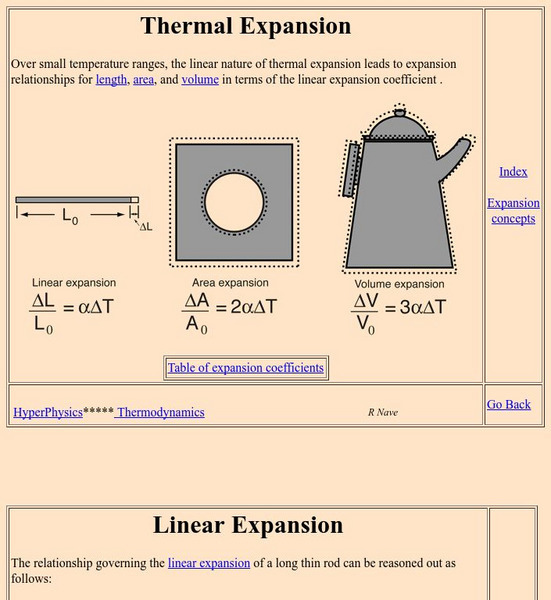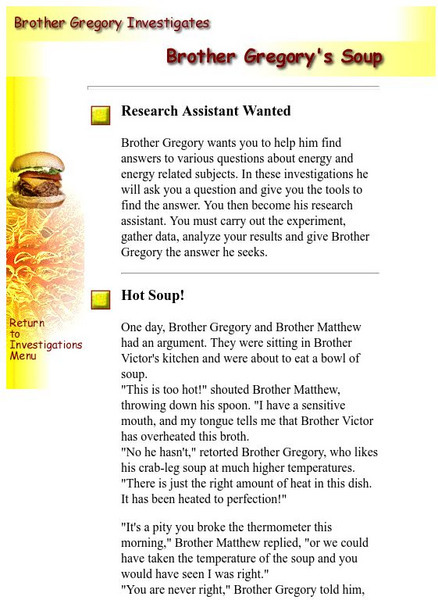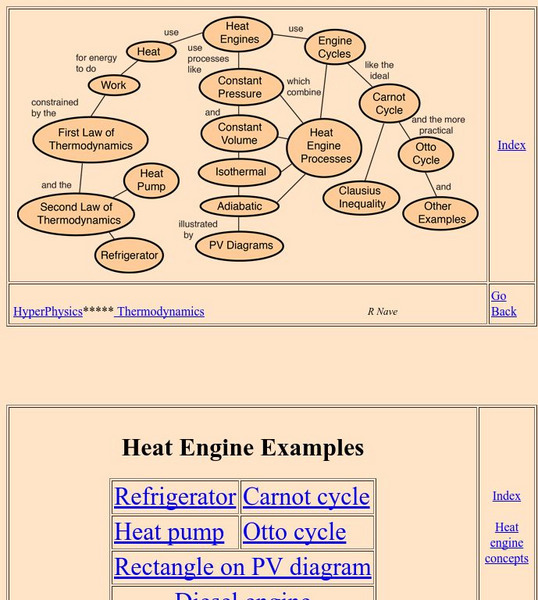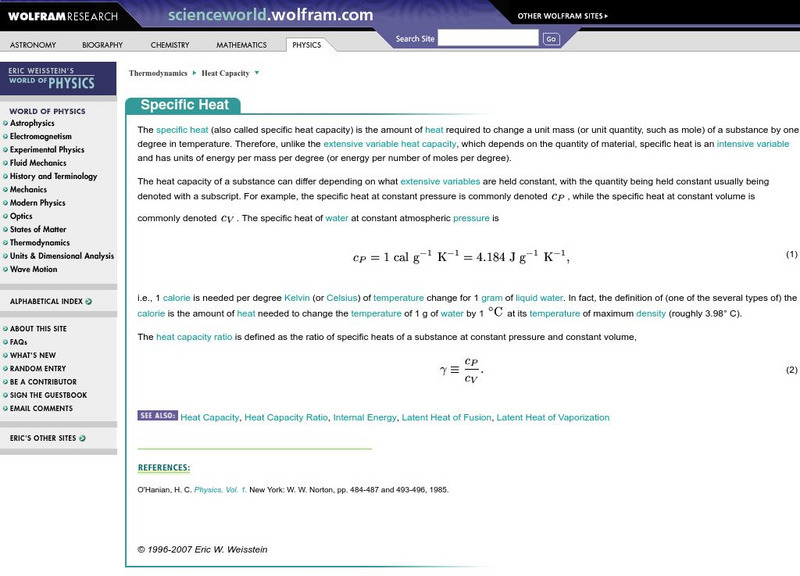Hi, what do you want to do?
Georgia State University
Georgia State University: Hyper Physics: Law Concepts
This site from Georgia State University Department of Physics and Astronomy is an indexing page for the HyperPhysics site. The page links to a variety of other pages which discuss concepts related to entropy and the second law of...
Georgia State University
Georgia State University: Hyper Physics: Zeroth Law of Thermodynamics
The principle of thermal equilibrium is discussed and explained. The zeroth law of thermodynamics is stated. Links to several other pages with related information are provided.
Georgia State University
Georgia State University: Hyper Physics: Heat Engine Cycle
The heat engine cycle is defined and discussed. So pressure-volume diagrams are introduced and their use in depicting the cycles of a heat engine is demonstrated. Informative graphics are accompanied by reason-filled explanations.
Georgia State University
Georgia State University: Hyper Physics: Temperature
A page describing the concept of temperature and temperature scales. An interactive JavaScript form allows the visitor to investigate the relationship between the Kelvin, Celsius and Fahrenheit scales; enter a value and allow the...
Georgia State University
Georgia State University: Hyper Physics: Thermal Expansion
Defines thermal expansion and elaborates on the concept of linear expansion. Provides the equation for linear expansion and includes an interactive JavaScript form which allows the visitor to investigate the relationship between...
Georgia State University
Georgia State University: Hyper Physics: Expansion Concepts
An indexing page from Georgia State University Physics Department which includes links to various other pages with information pertaining to thermal expansion. From expansion coefficients to equations to calculation and practice pages,...
Georgia State University
Georgia State University: Hyper Physics: Area Expansion
The concept of area expansion is presented and explained. An equation for calculating the amount of area expansion is provided.
Georgia State University
Georgia State University: Hyper Physics: Bimetallic Strips
The operation of bimetallic strips is explained and illustrated. The principle of thermal expansion is related to their operation. A link to applications of bimetallic strips is provided.
AAA Math
Aaa Math: All About Measurements
A complete tutorial that explains time, metric system, mass, length, volume, and temperature. Interactive practices and challenge games are included.
Concord Consortium
Concord Consortium: Molecular Workbench Showcase: Chemistry, Thermodynamics
Explore some virtual experiments on gases and vapor pressure, the Maxwell speed distribution, the barometric formula, and heat and temperature.
City University of New York
Brooklyn College:heat and Temperature Interactive Lab
Use this online activity to explore how various substances respond to changes in temperature. Learn how to calibrate a thermometer.
Georgia State University
Georgia State University: Hyper Physics: Heat Engine Concepts
An indexing page for the HyperPhysics site. The page contains a concept map of links to a variety of other pages which discuss concepts related to heat engines. All pages contain informative graphics and excellent explanations.
Georgia State University
Georgia State University: Hyper Physics: Speed of Sound
Physics tutorial on measuring the speed of sound in dry air. An interactive form allows the student to practice solving problems involving the temperature dependence of the speed of sound.
Cosmos 4 kids
Cosmos4 Kids: What Makes a Star?
Understand the three main characteristics of a star by reading this reference page and watching the short video.
E-learning for Kids
E Learning for Kids: Science: Atlantic Ocean: What Is Evaporation?
Explore with Julia how wind speed and temperature affect evaporation rate.
E-learning for Kids
E Learning for Kids: Science: Titanic Shipwreck: How Does Heat Travel?
David is exploring the Titanic shipwreck. He needs to stay warm down below in the water. Help him learn about heat and temperature.
University of Regina (Canada)
University of Regina: Math Central: Integers: Grade 6 (Using Thermometer)
Scroll partway down the page to find this lesson on decimals which incorporates the use of thermometers at an activity centre.
USA Today
Usa Today: Weather Basics: Understanding Humidity
This article is a guide to understanding humidity and related weather concepts. Includes helpful definitions of multiple terms.
Wolfram Research
Wolfram Science World: Specifiic Heat
This site has information on specific heat,the amount of heat required to change a unit mass of a substance by one degree in temperature. Included are many links and formulas.
University of Kentucky
Virtual Workshop: The Course on Temperature and Heat
On line course on Temperature and Heat for graduate credit or professional development, that emphasize hands on activities you can use in your classroom.
University of Illinois
University of Illinois Urbana Champaign: Other Forecasting Methods
This site contains a couple different ways that one can forecast the weather. Methods include the Climatology Method, the Analog Method, and Numerical Weather Prediction.
University of Illinois
University of Illinois Urbana Champaign: Ww2010: Units of Temperature
The Kelvin, Celsius and Fahrenheit temperature scales are discussed. Site lists and explains formulas for converting between the different scales.
Next.cc
Next: Climate
Complete these three activities to learn about climate, severe weather, and global warming. Includes links to explore related material.
Science Education Resource Center at Carleton College
Serc: Mini Lab: Investigating Gas Laws
In this activity, students investigate two gas laws: Charles and Boyle's. They will determine the relationship between gases and certain variables (temperature, volume and pressure), then watch a demonstration and determine what...



























